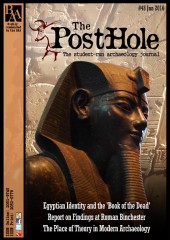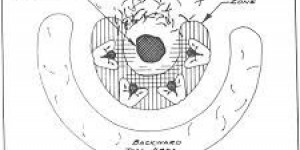Introduction
NERRF research project aims and background
In 2006, the North East Regional Research Framework for the Historical Environment proposed a synthesised research project based on the research agendas of curators, local governments, societies and groups, the heritage sector and academics. The key research priorities of NERRF were to expand on the current knowledge of the Iron Age-Roman transition, roads and communication, Roman military presence, native and civilian life, material culture, trade and industry, religion, burial, landscape and environment and the Roman-early medieval transition. In particular, the research agenda focused on the military remains connected with Hadrian’s Wall, placing emphasis on the effects of the wall on the pre-Roman landscape, the Roman road network, and the settlements around Hadrian’s Wall, situating them in their wider context. Research was concentrated at the site of Binchester, due to its excellent preservation and its significance among the garrisons along the road known as Dere Street. This particular area was of interest due to a lack of knowledge regarding the roads and surrounding military infrastructure (NERRF 2006).
Binchester: Past research
Binchester is a village situated on the banks of the River Wear, near Bishop Auckland, County Durham, in North East England (NGR centre: NZ 2095 3135). It contains the remains of the combined Roman fort (approx. 4.5 ha) and vicus settlement known as Vinovia, which was the focus of a seven year public excavation, open to amateur and academic interest, as well as intermittent excavation and analysis since 1878. The Binchester Excavation Project commenced in June 2009 and ended in July 2015. It was the joint landscape archaeology project of Durham University, Stanford University, and the Architectural and Archaeological Society of Northumberland and Durham- funded by Durham University, Vinovia and Durham County Council (Archaeological Services 2015: 2). The excavations were overseen by the Archaeological Services at Durham University, whose main focus was: ‘academic research, empowerment and education, and conservation and management’, according to the 2015 interim report (Archaeological Services 2015: 2). It is evident that these aims were met.
Archaeological Services education and training
Students and volunteers were provided with training by Archaeological Services at the beginning of each excavation. They were shown how to use the excavation kit, how to utilise the recording facilities such as context bags, context sheets, grid plans and photography, as well as how to record new trench heights using a dumpy level. Additionally, the volunteers learnt to recognise and record key finds such as bone, ceramics, iron and copper, as well as how to interact with the visiting public. Bulk finds and key ‘small’ finds were transferred to the Conservation Laboratory in Durham, and scientific dating was carried out where necessary.
Trench 1: Binchester fort excavation results
Geophysical survey
The initial geophysical survey of the area was undertaken by Time Team in 2007, who mapped the north and north east of the fort (Fig.1). This project revealed sepulchral areas outside the fort and vicus, including three mausolea and an inhumation. The geophysical survey undertaken at the beginning of the research project in 2009 (Fig.2) extended the area that had been previously surveyed, through the use of magnetrometry, resistivity, and ground penetrating radar.
Excavations 2009 - 2014
During the 2009 stage of excavation, the stone wall of the barrack block was uncovered running from north to north west, integrated with cobbles and paving slabs, and a series of pits and gullies, extending into parts of the via sagularis. There was also evidence of the extensive re-use and relining of the pits with stones, as well as an abundance of cattle bone deposition, which became more significant following the 2010 and 2011 excavations (Fig.3) (Archaeological Services 2009: Archaeological Services 2010: Archaeological Services, 2011). It may indicate that the use of the site changed during this period, evident from the initial mid-2nd to late 3rd century timber construction of the commander’s house, or praetorium, and its subsequent site formation processes (Ferris 2011). Petts (2013) states that the reconstructed 4th century AD stone praetorium was used as a slaughterhouse due to the abundance of cattle bone deposition dated to the later 4th century AD, which was contemporaneous with the filling of the pits in the barracks (Petts 2013).
A rectilinear post-Roman stone building was discovered in the south east rampart in the 2009 excavation, which was not aligned with the barrack block. The next stage of the excavation in 2010 revealed different phases of construction for the post-Roman building, with stone and cobbled building exteriors (Fig.3). The 2011 excavations uncovered more cobbled and paved surfaces across the majority of the fort, including the barrack buildings, showing internal divisions and evidence of drains. The south eastern corner of the trench was further excavated in 2012, revealing the raised stone walling that was supporting the post-Roman/medieval building. To the south west lay cobbled surfaces with evidence of medieval pottery. In addition, part of the barrack block showed evidence of reconstruction in the medieval period, which indicates that the medieval building and the barrack block were at one point contemporaneous. The rectilinear building and the reconstructed barrack were removed during this stage revealing stone and cobbled surfaces that predated the previous structures, and a stone structure attached to the west side of the barracks (Archaeological Services 2012).
In 2013 an earlier phase of the barrack block was uncovered, showing the soldiers’ accommodation, the stables and the officer’s quarters, with the eastern section evidencing the reduction of the block to half its original width. The internal layout incorporated paving, stone and clay walls, and drains and hearths (Archaeological Services 2013). The 2014 excavation revealed an earlier phase of construction of the barrack block, with contemporaneous cobbled paved flooring to the east and west, and evidence of timber partitions. The alignment of these partitions indicated a separation of the stables and accommodation. Evidence revealed that the west wall had been rebuilt at a later phase, and that the timber spine had been removed. In addition, a latrine block was uncovered against a north east corner tower in the fort wall, and evidence of a stone building was found at the north of the barrack block (Archaeological Services 2014).
Excavation 2015
During my three weeks of excavation at Binchester in June 2015, I remained at the south of trench 1 in the barrack block, and later in the south west of the trench, working with a group of three students. By this point, trench 1 evidenced the stables within the barrack blocks to the south of the fort, and a latrine block and corner tower to the north of the fort against the wall. I was assigned to the south-west part of the trench, which contained the barracks with incorporated stables, and a large stone-lined pit (Fig.4 & Fig.5). We removed the top layers of soil and cobbles using trowels and mattocks, as directed by members of Archaeological Services. We intended to reveal more paved and cobbled surfaces throughout the interior and exterior of the barrack block, showing different phases of construction that were similar to the more recent versions of the structure. Post holes, beam slots and stake holes were uncovered after the removal of the surfaces, alongside the remains of a large burnt timber post in the south corner of the trench (Fig.5 & Fig.6). Removing the burnt surface exposed another cobbled surface, indicative of the earlier wooden barrack design. It is clear from the burnt timber and early post holes, as well as from the phases of early reconstruction, that the original late 1st century AD fort was a timber construction that had been demolished. This may have been due to the fact that it could be burnt down and rebuilt without a substantial consumption of time. The second fort constructed of stone in the Antonine period was half the size of the earlier timber construction, and gave rise to the vicus settlement at Vinovia (Ferris 2011).
Trench 2, Binchester vicus excavation results
Excavation commenced at the vicus (trench 2) during 2010, to the east of the fort’s eastern entrance. This revealed a later road than Dere Street along the same alignment, running along the edge of trench 2 from south to west. Evidence of a rectangular bath house was discovered in the east end of the trench, and another rectangular building to the west, as well as medieval and post-medieval deposition (Archaeological Services 2010). The post-medieval deposition was removed during the 2011 excavation, which included the removal of the over-lying cobbled surface along Dere Street. This revealed more of the bath house to the east, as well as evidence of repaving and stone-lined pits that were filled with an abundance of animal bone, assumed to be contemporaneous with the bone-filled pits that were discovered across the earlier stratigraphy of the fort and praetorium from the late 4th century AD. It was clear that the settlement of Vinovia had changed its function during this period, and it is assumed that it was being used for large scale butchery (Archaeological Services 2011: Petts 2013). The pits were excavated and removed in 2012, and more of the bath house was revealed during 2012 and 2013, evidencing extensive reconstruction and bricking-up of the rooms, windows and doors over different phases (Archaeological Services 2012: Archaeological Services 2013). The 2014 excavation revealed what is thought to have been the apodyterium within the bath house. A plunge pool with drainage system was discovered in the large room in 2015, and the eastern part of the bath house revealed a hypocaust and flue (Fig.7).
Discussion: continued usage and change in function
Vinovia
It is clear that Vinovia was once an important part of the frontier system along Dere Street (Fig.8), due to its constant reconstruction and continued use during Roman and sub-Roman occupations (Petts 2013). Evidence of the rebuilding and redevelopment of early wooden and later stone features within the fort and vicus demonstrates the significance of the fort and civilian settlement with regards to the protection of the main trade network. The fort changed in function during the early to mid-2nd century AD, from barracks to industrial use, and saw the subsequent construction of the praetorium (Ferris 2011). The excavated pottery from the Roman period found at Vinovia dates from no later than the late 4th century AD, in accordance with the economic collapse in Roman Britain. This corresponds with the radiocarbon date from a cattle bone excavated from one of the larger pits within the fort, in addition to the radiocarbon dates of the cattle bones from the praetorium. Both show a clear change in the use of the settlement during the late 4th century AD (Petts 2013). It has been suggested that the industrial activity and large scale dumping was either to maintain a substantial remaining population at Vinovia, or for meat redistribution in the local area, including the forts and urban centres along Dere Street and Hadrian’s Wall (Ferris 2011: Petts 2013). However, similar changes in the use of space during the same period were documented at Eboracum (York) (Fig.8), and it has been argued that the large amount of animal bone deposition was due to butchery for elite feasting (Collins 2012). Despite the apparent lack of butchery markings on the bones recovered from some sites, the substantial refuse deposition of animal bones is typical of specialised butchery at Roman military settlements (O’Connor 2000: 54). That said, there are clear cut marks on the bones excavated from the pits at Binchester, and in addition several military and civilian sites in Britain have shown that carcass reduction and extensive rubbish deposition is essentially a Roman practice and military-related, apparent at sites within the northern frontier system (Dobney 2011).
Hadrian’s Wall
Evidence suggests large-scale dumping of animal bones towards the western end of Hadrian’s Wall at Banna (Birdoswald) fort in Cumbria (Fig. 8), which saw the construction of its vicus during the 3rd century AD, and continued to be occupied after the troops were withdrawn during the late 4th to early 5th century AD. Similarly, excavations at the fort at Arbeia, South Shields (Fig.8) has revealed evidence of large-scale dumping as well as continued occupation at the site after troop withdrawal. Moreover, the reduction and demolition of granaries dating from the 3rd to late 4th century AD is evident at Arbeia (South Shields), Vercovicium and Vindolanda (both in Hexham along the centre of Hadrian’s Wall) (Fig.8), which is indicative of a reduced need for food storage around that time, and suggests that the occupants may have been sourcing their food locally or using their own supplies, to an extent which could maintain such populations (Collins 2012). In acknowledgement of the similarities between the sites, it would be reasonable to assume that either interpretation of Vinovia’s evidence for butchery is credible, or even that it was maintaining its own population as well as distributing meat to other sites and urban areas.
Dere Street
The praetorium at Vinovia had been left to decay after the late 4th to early 5th century AD. The area that was once the fort transformed into an area of extensive meat processing, and it is not clear who inhabited the settlement directly after the withdrawal of the Roman troops (Ferris 2011: Petts 2013). However, evidence suggests that the organisation of industrial activities was a ‘centrally organised and managed activity’, which would indicate that there was still a degree of social structure present (Ferris 2011: 123). Nevertheless, the large scale deposition and neglect of the buildings indicates a shift in priorities, possibly as a result of Roman acculturation and the subsequent abandonment of troops (Petts, 2013). Isotopic analysis of human bones in Yorkshire has shown that there was a decrease in diversity at Roman military settlements that protected Dere Street, such as Cataractonium (Catterick), demonstrating that military recruitment had become more ‘localised’ towards the end of the Roman period (Chenery 2011: 1525). The cessation of tax flow between Britain and Rome, and the change in recruitment, may have also resulted in the change in priorities regarding building maintenance, food storage and procurement, and the change in use of the military settlements along Hadrian’s Wall (Collins 2012).
Concluding on the wider research aims
The excavation project at Binchester has revealed the importance of the military settlements along Dere Street, and their relationship with the forts and settlements at Hadrian’s Wall. This is evident in the continuous reconstruction and continued functionality of the buildings and space, although no evidence of pre-Roman activity has been discovered. The late Roman and early medieval transition has revealed how the military settlements in the north of Britain were affected by the economic difficulties of the Roman Empire further west. This is seen in the changing form and function of the military settlements; the large scale dumping and butchery, the cessation of building reconstruction, and the discontinuation of granaries. However, it isn’t clear if the evidence of butchery at Binchester is indicative of a substantial remaining population, or if meat was simply distributed between military sites. Recent studies have provided the isotope ratios of 4th century AD inhumations found in cemeteries around the Dere Street military sites of York and Catterick. It may be interesting to investigate whether or not there were any sites with high meat consumption levels but little or no evidence of butchery. This may indicate that military settlements like Vinovia were practicing large scale butchery for meat distribution to the settlements nearby.
Bibliography
- Archaeological Services Durham University. (2009) The Binchester International Field School Interim Report 2009 - 10. Internal Durham University Report. Unpublished.
- Archaeological Services Durham University. (2010) The Binchester International Field School Interim Report 2010 - 11. Internal Durham University Report. Unpublished.
- Archaeological Services Durham University. (2011) The Binchester International Field School Interim Report 2011 - 12, Report 2910. Internal Durham University Report. Unpublished.
- Archaeological Services Durham University. (2012) The Binchester International Field School Interim Report 2012 - 13, Report 3081. Internal Durham University Report. Unpublished.
- Archaeological Services Durham University. (2013) The Binchester International Field School Interim Report 2013 - 14, Report 3375. Internal Durham University Report. Unpublished.
- Archaeological Services Durham University. (2014) The Binchester International Field School Interim Report 2014 - 15, Report 3809. Internal Durham University Report. Unpublished.
- Archaeological Services Durham University. (2015) The Binchester International Field School Interim Report 2015, Report 3889. Internal Durham University Report. Unpublished.
- Chenery, C., Eckardt, H., Muldner, G. (2011) ‘Cosmopolitan Catterick? Isotopic evidence for population mobility on Rome’s Northern frontier’, Journal of Archaeological Science, 38, pp. 1525 – 1536.
- Collins, R. (2012) Hadrian’s Wall and the end of empire: The Roman frontier in the 4th and 5th Centuries. Oxon: Routledge.
- Cool, H.E.M. (2006) Eating and drinking in Roman Britain. Cambridge: Cambridge University Press.
- Dobney, K. (2001) ‘A Place at the Table: The Role of Zooarchaeology within a Roman Research Agenda’, in: S. James & M. Millett, (eds.) Romans and Britons: Advancing an Archaeological Agenda. York: Council for British Archaeology, CBA Research Report 125, pp. 36–45.
- Ferris, I. (2011) Vinovia. Gloucestershire: Amberley Publishing.
- Gerrard, C. & Petts, D. (2006) Shared visions: The North-East regional research framework for the historic environment. Durham: Durham County Council.
- Hoffman, G. (2013) The Roman Invasion of Britain: Archaeology Versus History. Barnsley: Pen & Sword Archaeology.
- Luzzato, G. (2006) An economic history of Italy: From the fall of the Roman Empire to the beginning of the 16th Century. Oxon: Routledge.
- O’Connor, T.P. (2000) ‘Bones as evidence of meat production and distribution in York’. In: White, E., (ed) Feeding a city: York. The provision of food from Roman times to the beginning of the twentieth century. Devon: Prospect Books, pp. 43 – 60.
- Petts, D. (2013) ‘Military and civilian: Reconfiguring the end of Roman Britain in the North’, European Journal of Archaeology, 16(2), pp. 314 – 335.
- Wessex Archaeology (2008) Binchester Roman fort County Durham: Archaeological Evaluation and Assessment of Results. Available at: http://www.wessexarch.co.uk/files/65302_Binchester%20report.pdf (Accessed: 25th Nov 2015).






